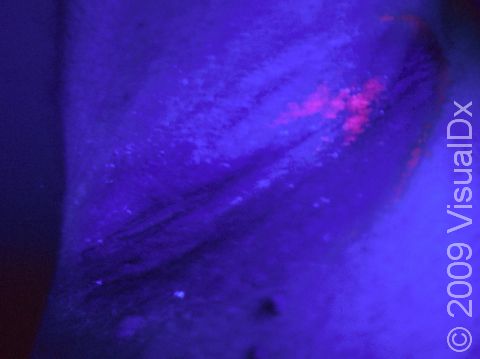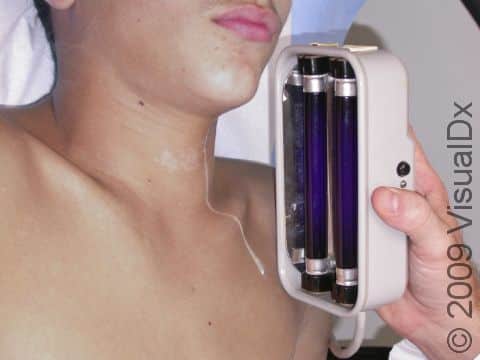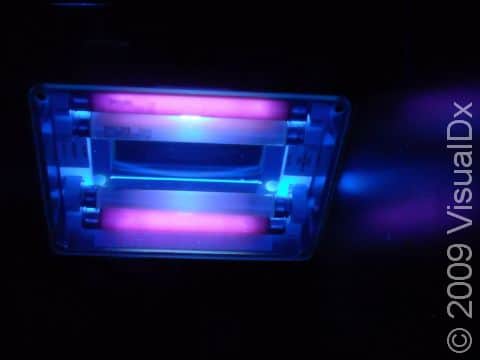Wood's Lamp Examination
A Wood’s lamp is a device that emits ultraviolet (UV) light that is commonly used by medical professionals such as dermatologists to assist in the diagnosis of various pigment and infectious disorders. The examination is performed in a completely dark room, allowing the Wood’s light to shine directly on the affected area for a few seconds to look for any changes in color, known as fluorescence. Normal skin does not fluoresce under the light of a Wood’s lamp. But if a fungal or bacterial infection or pigment disorder is present, Wood’s lamp examination can strengthen or lessen the suspicion of a particular diagnosis based on the color of fluorescence of the affected skin being illuminated.
Some of the medical issues that typically fluoresce under Wood’s light include:
- Fungal infections, such as tinea infections.
- Bacterial infections, such as erythrasma.
- Porphyria cutanea tarda (urine).
- Vitiligo and other pigmentary disorders.
What to Expect During Your Visit
In a completely dark room, your medical professional will hold the Wood’s lamp 4-5 inches from the area being examined. The medical professional will look for any colorful fluorescent changes that may suggest or confirm a particular diagnosis. This portion of the examination usually lasts less than a minute. You should feel no discomfort during the examination.
What to Expect After Your Visit
The results of the Wood’s lamp examination are immediate. Based on your results, your medical professional may decide to treat a skin condition supported by the results of the Wood’s lamp examination or perform additional tests if the Wood’s lamp examination is inconclusive.
Follow-Up Care
After Wood’s lamp examination, no follow-up care is needed specific to the examination itself. Depending on the results of the examination; however, your medical professional may recommend treatment of a skin disorder.
Risks and Potential Side Effects
The risks associated with Wood’s lamp examination are minimal to none. Note, however, that it is best to avoid looking directly into the UV light. There is no pain associated with the procedure and no side effects as a result.
When to Seek Medical Care
If you are being treated for a diagnosis that was identified by Wood’s lamp examination and it is not going away as anticipated, contact your medical professional. There may be another condition that was not detected by Wood’s lamp examination that your medical professional may need to treat as well.
Trusted Links
References
Burgin S. Bedside diagnostic maneuvers. In: Susan Burgin. Guidebook to Dermatologic Diagnosis. McGraw Hill; 2021.
Craddock LN, Schieke SM. Superficial fungal infection. In: Kang S, Amagai M, Bruckner AL, Enk AH, Margolis DJ, McMichael AJ, Orringer JS, eds. Fitzpatrick’s Dermatology. 9th ed. New York, NY: McGraw-Hill Education; 2019.
Yancey KB, Lawley TJ. Approach to the patient with a skin disorder. In: Loscalzo J, Fauci AS, Kasper DL, Hauser SL, Longo DL, Jameson JL, eds. Harrison’s Principles of Internal Medicine. 21st ed. McGraw Hill; 2022.
Last modified on May 9th, 2024 at 2:02 pm

Not sure what to look for?
Try our new Rash and Skin Condition Finder


